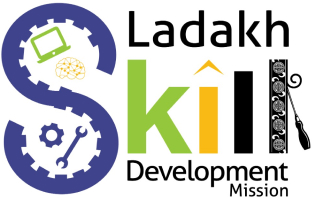
The Ladakh Skill Development Mission logo is designed with several meaningful elements that symbolize various aspects of skill development and growth. Here's a breakdown of the elements and their significance:
"S" with Technical and Mechanical Elements: The logo features the letter "S" divided into two sections. These sections represent the technical and mechanical aspects of skill development, suggesting the blend of technology and hands-on skills required in today's evolving industries.
Laptop with Brain: Within one of the sections of the "S," there's an illustration of a laptop with a brain. This symbolizes the importance of human thinking and innovation alongside technological advancements, such as AI. It highlights that while technology is crucial, human creativity and intellect play a vital role in skill development and innovation.
Mechanical Part of a Machine: The inner part of the "S" section also depicts the mechanical component of a machine. This reinforces the idea of practical skills and technical proficiency being integral to skill development.
"^" in the 'I': The symbol "^" placed within the "I" in the word "Skill" represents growth. This upward-pointing arrow symbolizes progress, advancement, and improvement achieved through skill development.
Ascending "ill" Letters: The letters "ill" in the word "Skill" are designed in ascending order. This design choice signifies the concept of growth and acceleration, suggesting that skill development leads to continuous improvement and increasing proficiency.
Design in the Last 'l': The last letter "l" features a design resembling the traditional "wood carving" art of Ladakh, which holds a Geographical Indication (GI) tag. This element represents the cultural heritage and traditional skills of the region. The tool placed within the "l" emphasizes that skill development is an ongoing process, and there's always room for "Upskilling" and "Reskilling."
Overall, the Ladakh Skill Development Mission logo effectively communicates the blend of technical and practical skills, the significance of human creativity and innovation, the importance of continuous growth, and respect for local traditions and crafts




